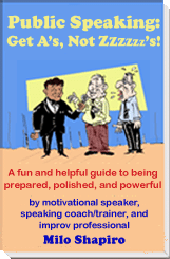Column #3:
Vocal variety, part 2
 |
|
Q: I've been told that I ought to use more vocal
variety, but this doesn’t come naturally to me. What
can I do?
− W.L., Tierrasanta, CA |
In our last column, we began looking at how speakers
can utilize my coaching technique called the Seven Variants of
Vocal Variety™. The first three we
covered were Volume, Pitch, and Speed. Let’s continue.
4) Breakpoints. One of the
classic moments in The Rocky Horror Picture Show is when
the doctor says, “I see you shiver with antici...” and everyone
stands still, almost breathless, waiting for him to finally say
“...pation.” While I wouldn’t normally recommend five second
pauses in the middle of words, there’s something to be said for
the power of wisely used pauses.
Because any silence from the platform
is cause for a bit of dynamic tension, create it on purpose.
Say the following sentence first completely ignoring the ^
characters and then again putting a 1-second pause in each spot
that I've placed them:
“You
kids go into that house and I don’t
want one ^ single ^ word ^ of complaint.”
If Mom or Dad said it they way that had the
pauses, I'm betting that it would get a lot more attention.
5) Holdings. Holdings are almost the
opposite of breakpoints. They let a message of a word sink in,
too, but from the use of sound rather than the use
of silence. Holdings involve the stretching of a sound −
usually a vowel, but some
consonants work, too. This gives you a chance to stress a word
without having to change volume or pitch, although you could.
In our example, say it as written and with a holding on the two
underlined letters.
“Let this be the last thing you say if you
really want to make an impact.”
The “L” might feel
weird but it’s doable. And if you don’t like it, try the “a”
instead. That’s why we rehearse these things: to know in
advance what we’re going to do because we liked it earlier.
6) Emotion. While no one should
look like they are going through a traumatic therapy session
while on the platform, your audience wants to connect with you.
It’s really okay − and powerful − to show a little humanity.
Let a serious moment show in your
voice. Give an almost-laugh to your tone when something is a
source of good news. Put a hint of a fearful tone to a sentence
on something of concern. Let your pride tone show when the
message deserves it. This might feel vulnerable at first, but
audiences appreciate your willingness to open yourself a bit.
7) Intonation. This is a catch-all for all those fun
things we can do with our voices. We can sound more nasal,
breathy, gruff, childish, mournful, and so much more. When I
quote people, I'll sometimes even give them an accent that the
original person didn’t have, but it’s just a nice break from
listening to my base tone and sets that character apart in my
story. It also keeps me from having to say “He said” over and
over because “he” sounds different from me!
You needn’t go overboard with your use of
these seven considerations, but peppering your presentation with
some of them can make a great difference. Honestly!
|















